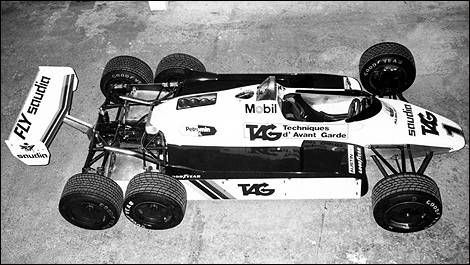Australian Alan Jones drove the FW07D and the newcomer Keke Rosberg, Nico’s father, tested the FW08B during the winter of 1981-82.
“We were all intrigued to see if we could balance a car that had such a large contact patch at the rear and we quickly discovered that we could. I remember (test driver) Jonathan Palmer telling me that he couldn’t really tell that there were four wheels at the back, although the traction out of slow corners was phenomenal,” Head continues.
“The FW08B had no handling problems as such – it didn’t understeer like a pig, as many people expected – but there was so much hardware on the car that it was bl**dy heavy. It was going to be a huge challenge to get it down to a reasonable weight.
“The car was about 250mm longer than a standard FW08 and all four rear wheels were driven. There was a differential between the two front wheels and the two rear wheels, but there was no diff between the front pair and the rear pair,” Head explains.
“In the end, the six-wheeler was banned after someone in a FOCA meeting said it would drive up costs and cause chaos during pit stops. The regulations were changed to say a car could only have four wheels, of which only two could be driven.
“After that, we had no option other than to pursue the turbo route with Honda. It was clear that horsepower was the order of the day,” Head concluded.
 |
| Rear section of the FW08B. (Photo: Williams) |
“We were all intrigued to see if we could balance a car that had such a large contact patch at the rear and we quickly discovered that we could. I remember (test driver) Jonathan Palmer telling me that he couldn’t really tell that there were four wheels at the back, although the traction out of slow corners was phenomenal,” Head continues.
“The FW08B had no handling problems as such – it didn’t understeer like a pig, as many people expected – but there was so much hardware on the car that it was bl**dy heavy. It was going to be a huge challenge to get it down to a reasonable weight.
“The car was about 250mm longer than a standard FW08 and all four rear wheels were driven. There was a differential between the two front wheels and the two rear wheels, but there was no diff between the front pair and the rear pair,” Head explains.
“In the end, the six-wheeler was banned after someone in a FOCA meeting said it would drive up costs and cause chaos during pit stops. The regulations were changed to say a car could only have four wheels, of which only two could be driven.
“After that, we had no option other than to pursue the turbo route with Honda. It was clear that horsepower was the order of the day,” Head concluded.
 |
| (Photo: Williams) |


